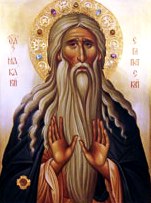Abba Macarius
| Saint Macarius of Egypt | |
|---|---|

An icon of Saint Macarius of Egypt
|
|
| Born | c. 300 Shabsheer (Shanshour), Al Minufiyah Governorate, Egypt |
| Died | 391 Scetes, Egypt |
| Venerated in |
Orthodox Church Oriental Orthodox Churches Roman Catholic Church |
| Major shrine | Monastery of Saint Macarius the Great, Scetes, Egypt |
| Feast | 15 January (West, Roman Catholic) 19 January (Eastern Orthodox) 27 Paremhat (= 4 April) (Oriental Orthodox) |
Macarius of Egypt (Greek: Ὅσιος Μακάριος ο Ἀιγύπτιος, Osios Makarios o Egyptios; Coptic: Ⲙⲁⲕⲁⲣⲓⲟⲥ; Arabic: القديس مقاريوس, Maqaroos al Qadis, 300-391) was an Egyptian Christian monk and hermit. He is also known as Macarius the Elder, Macarius the Great and The Lamp of the Desert.
Macarius was born in Upper Egypt. A late tradition places his birthplace in the village of Shabsheer (Shanshour), in Al Minufiyah Governorate, Egypt around 300 A.D. At some point before his pursuit of asceticism, Macarius made his living smuggling saltpeter in the vicinity of Nitria, a vocation which taught him how to survive in and travel across the wastes in that area.
St. Macarius is known for his wisdom. His friends and close kin used to call him Paidarion Geron (Greek: Παιδάριον Γερών,which when compounded as Paidiogeron led to Coptic: Ⲡⲓⲇⲁⲣ Ⲓⲟⲩⲅⲉⲣⲟⲛ, Pidar Yougiron) which meant the “old young man”, i.e. “the young man with the elders’ wisdom.”
At the wish of his parents Macarius entered into marriage, but was soon widowed. Shortly after, his parents departed as well. Macarius subsequently distributed all his money among the poor and needy. He found a teacher in an experienced Elder, who lived in the desert not far from the village. The Elder accepted the youth, guided him in the spiritual science of watchfulness, fasting and prayer, and taught him the handicraft of weaving baskets. Seeing his virtues, the people of his village brought him to the bishop of Ashmoun who ordained him priest.
...
Wikipedia
